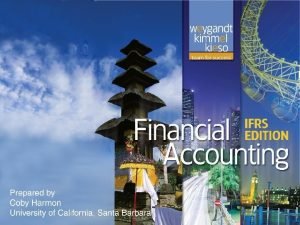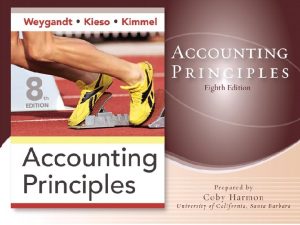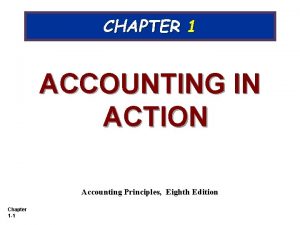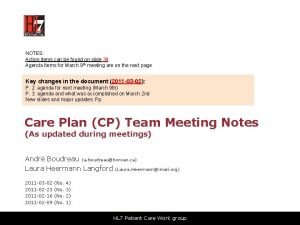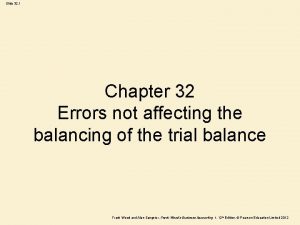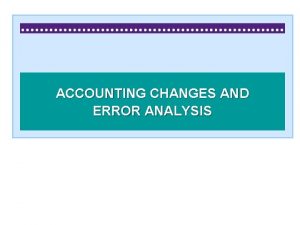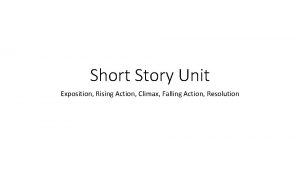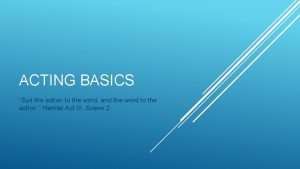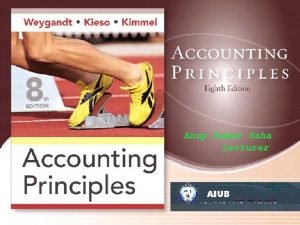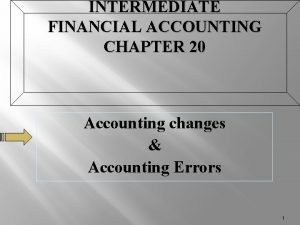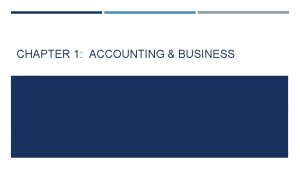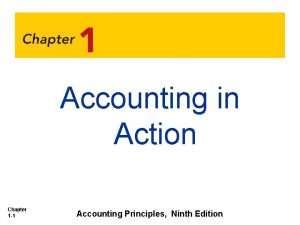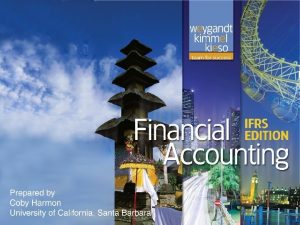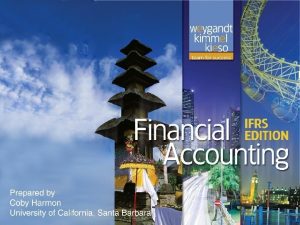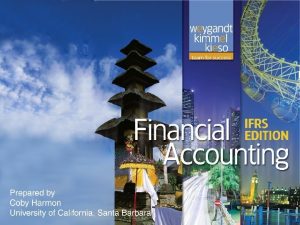Slide 1 1 Chapter 1 Accounting in Action


















- Slides: 18

Slide 1 -1

Chapter 1 Accounting in Action Financial Accounting, IFRS Edition Weygandt Kimmel Kieso Slide 1 -2

Accounting in Action What is Accounting? Three activities Who uses accounting data? Slide 1 -3 The Building Blocks of Accounting Ethics in financial reporting Accounting standards Assumptions The Basic Accounting Equation Assets Liabilities Equity Using the Accounting Equation Transaction analysis Summary of transactions Financial Statements Income statement Retained earnings statement Statement of financial position Statement of cash flows

What is Accounting? The purpose of accounting: (1) to identify, identify record, record and communicate the economic events of an Slide 1 -4 (2) organization to (3) interested users. SO 1 Explain what accounting is.

What is Accounting? Three Activities Illustration 1 -1 The activities of the accounting process The accounting process includes the bookkeeping function. Slide 1 -5 SO 1 Explain what accounting is.

What is Accounting? Who Uses Accounting Data Internal Users Human Resources Taxing Authorities External Users Labor Unions Finance Management Customers Creditors Marketing Slide 1 -6 Regulatory Agencies Investors SO 2 Identify the users and uses of accounting.

What is Accounting? Common Questions Asked User 1. Can we afford to give our employees a pay raise? Human Resources 2. Did the company earn a satisfactory income? Investors 3. Should any product lines be eliminated? Management 4. Is cash sufficient to pay dividends to shareholders? Finance 5. What price for our product will maximize net income? Marketing 6. Will the company be able to pay its debts? Creditors Slide 1 -7 SO 2 Identify the users and uses of accounting.

The Basic Accounting Equation Assets = Liabilities + Equity Provides the underlying framework for recording and summarizing economic events. Applies to all economic entities regardless of size. Slide 1 -8 SO 6 State the accounting equation, and define its components.

The Basic Accounting Equation Assets = Liabilities + Equity Provides the underlying framework for recording and summarizing economic events. Assets Resources a business owns. Provide future services or benefits. Cash, Inventory, Equipment, etc. Slide 1 -9 SO 6 State the accounting equation, and define its components.

The Basic Accounting Equation Assets = Liabilities + Equity Provides the underlying framework for recording and summarizing economic events. Liabilities Claims against assets (debts and obligations). Creditors - party to whom money is owed. Accounts payable, Notes payable, etc. Slide 1 -10 SO 6 State the accounting equation, and define its components.

The Basic Accounting Equation Assets = Liabilities + Equity Provides the underlying framework for recording and summarizing economic events. Equity Ownership claim on total assets. Referred to as residual equity. Share capital and retained earnings. Slide 1 -11 SO 6 State the accounting equation, and define its components.

The Basic Accounting Equation Illustration 1 -7 Revenues result from business activities entered into for the purpose of earning income. Generally results from selling merchandise, performing services, renting property, and lending money. Slide 1 -12 SO 6 State the accounting equation, and define its components.

The Basic Accounting Equation Illustration 1 -7 Expenses are the cost of assets consumed or services used in the process of earning revenue. Common expenses are salaries expense, rent expense, utilities expense, tax expense, etc. Slide 1 -13 SO 6 State the accounting equation, and define its components.

The Basic Accounting Equation Illustration 1 -7 Dividends are the distribution of cash or other assets to shareholders. Ø Reduce retained earnings Ø Not an expense Slide 1 -14 SO 6 State the accounting equation, and define its components.

The Basic Accounting Equation Classify the following items as issuance of shares, dividends, revenues, or expenses. Then indicate whether each item increases or decreases equity. Slide 1 -15 Classification Effect on Equity 1. Rent expense Expense Decrease 2. Service revenue Revenue Increase 3. Dividends Decrease 4. Salaries expense Expense Decrease Solution on notes page SO 6 State the accounting equation, and define its components.

Using The Accounting Equation Transactions are a business’s economic events recorded by accountants. May be external or internal. Not all activities represent transactions. Each transaction has a dual effect on the accounting equation. Slide 1 -16 SO 7 Analyze the effects of business transactions on the accounting equation.

Using The Accounting Equation Illustration: Are the following events recorded in the accounting records? Illustration 1 -8 Discuss product design with customer. Event Purchase computer. Criterion Is the financial position (assets, liabilities, or equity) of the company changed? Pay rent. Record/ Don’t Record Slide 1 -17 SO 7 Analyze the effects of business transactions on the accounting equation.

Using The Accounting Equation Transaction Analysis Slide 1 -18 SO 7 Analyze the effects of business transactions on the accounting equation.
 Heel toe dance
Heel toe dance Basic accounting chapter 1
Basic accounting chapter 1 Accounting in action chapter 1 answers
Accounting in action chapter 1 answers Chapter 1 accounting in action
Chapter 1 accounting in action Intermediate accounting chapter 1
Intermediate accounting chapter 1 Factor
Factor Action items slide
Action items slide Error of complete reversal of entry
Error of complete reversal of entry Slide error in accounting
Slide error in accounting Accounting changes and error analysis
Accounting changes and error analysis In media res literary definition
In media res literary definition The lion and the mouse climax
The lion and the mouse climax 5 stages of a plot
5 stages of a plot Exposition short story
Exposition short story Suit the action to the word the word to the action meaning
Suit the action to the word the word to the action meaning Chapter 1 accounting
Chapter 1 accounting Accounting in action
Accounting in action Assets = liabilities + stockholders' equity
Assets = liabilities + stockholders' equity Computerised accounting system notes
Computerised accounting system notes

